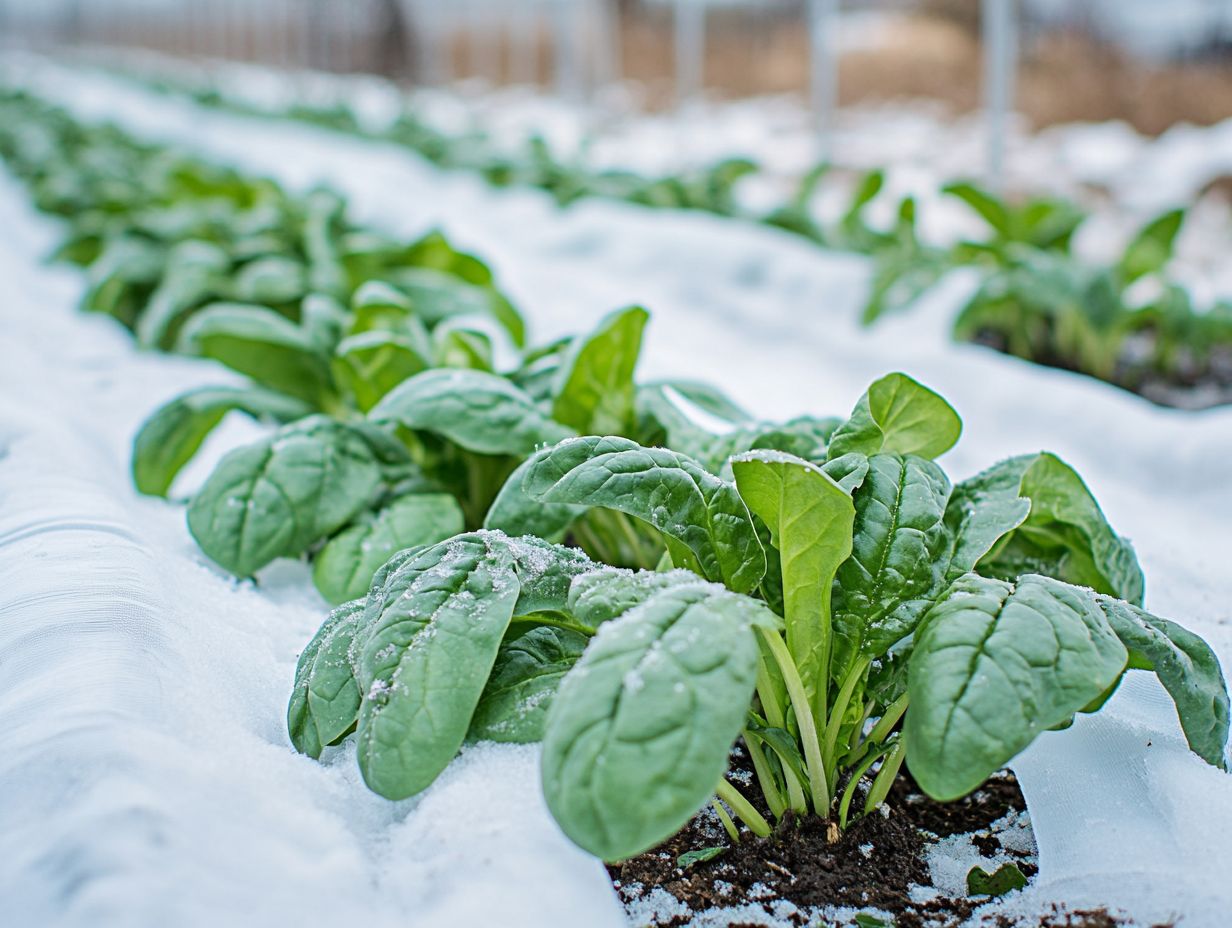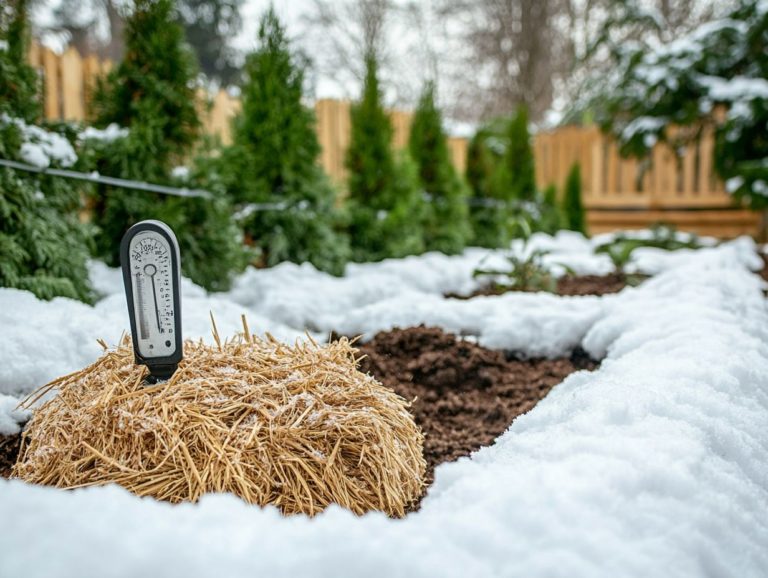How to Grow Spinach in Cold Weather
Spinach is more than just a nutritious powerhouse. It stands as one of the hardiest leafy greens, thriving even in colder temperatures.
If you’re eager to cultivate a flourishing spinach crop during the chilly months, this guide is tailored for you. You ll learn everything from selecting the right seeds and soil to creating an optimal growing environment, mastering planting techniques, and providing proper care.
You’ll also learn effective methods for harvesting and storing your spinach, along with solutions for common issues, ensuring a bountiful yield. Get ready to master the art of cold weather gardening with delicious spinach!
Contents
- Key Takeaways:
- Why Spinach is Ideal for Cold Weather
- Preparing for Spinach Growth
- Planting and Caring for Spinach
- Harvesting and Storing Spinach
- Troubleshooting Common Issues
- Frequently Asked Questions
- Preparation
- 1. How do I prepare my garden for growing spinach in cold weather?
- 2. Can I grow spinach in containers during the cold weather?
- 3. When is the best time to plant spinach in cold weather?
- 4. How can I protect my spinach from freezing temperatures?
- 5. How often should I water my spinach during cold weather?
- 6. Can I use mulch to protect my spinach in cold weather?
Key Takeaways:

- Spinach is a cold weather superstar, thriving in temperatures as low as 20 F. Its hardiness makes it an ideal crop for winter gardens.
- To ensure successful growth, choose cold-resistant spinach seeds and well-draining, nutrient-rich soil. Creating a sheltered and sunny growing environment is also key.
- When harvesting spinach, pick the outer leaves first and store them in a plastic bag in the fridge. Be vigilant about pests and diseases, and protect your plants from harsh weather conditions.
Why Spinach is Ideal for Cold Weather
Spinach stands out as a remarkably versatile leafy green, flourishing in the chill of winter. This makes it an exceptional selection for your winter gardening endeavors.
Its cold-hardy nature enables it to endure freezing temperatures, allowing you to harvest nutrient-rich greens even amidst the harshest winter conditions. This resilience, paired with a delightful flavor and a notable sugar content, means you can savor fresh spinach long after other vegetable crops have bid farewell for the season.
Plus, the option to cultivate spinach in low tunnels or cold frames elevates its charm, ensuring strong growth and superior leaf quality throughout the colder months.
Preparing for Spinach Growth
Preparing for spinach growth requires you to create the ideal conditions for this nutrient-rich leafy green to thrive. First and foremost, choosing rich soil mixed with compost or organic fertilizer is essential for optimal plant care and strong growth.
Pay close attention to seasonal planting times, especially when it comes to monitoring soil temperature and moisture levels. These factors are vital for successful germination and robust seedlings. By honing in on these foundational elements, you can effectively lay the groundwork for a bountiful spinach crop throughout the seasons.
Choosing the Right Seeds and Soil
Choosing the right seeds and soil is crucial for your success in cultivating spinach. Consider various varieties like Viroflay and Acadia. Selecting nutrient-rich soil provides your seedlings with the essential support they need for robust growth and optimal yield.
Additionally, incorporating organic fertilizers enhances nutrient availability without jeopardizing soil health. By addressing potential germination issues early on, you can prevent setbacks in the growth process and pave the way for a thriving spinach crop.
Understanding your local climate plays a significant role in your choice of spinach varieties. Some flourish in cooler temperatures while others thrive in warmth. This knowledge not only helps you maximize growth potential but also contributes to creating a resilient garden.
Conducting soil tests allows you to determine pH levels and nutrient content. This enables you to amend your soil effectively with lime or compost as needed.
Common germination challenges such as insufficient moisture or improper seed placement can be managed by following recommended sowing depths and maintaining consistent watering schedules. With these strategies in place, you can ensure a bountiful harvest of spinach, no matter the growing environment.
Start your spinach gardening journey today and enjoy fresh greens all winter long!
Creating an Optimal Growing Environment
Creating an optimal environment for growing spinach is crucial for maximizing yields and ensuring the health of your plants. By employing methods like cold frames or high tunnels, you can significantly enhance light transmission and shield your spinach from harsh weather.
Delving deeper into these techniques, you ll find that each method comes with its own set of advantages and challenges. Cold frames are relatively easy to construct and can even be made from repurposed materials, giving you an early advantage in the growing season. Just remember to monitor temperatures carefully, especially on sunny days, to avoid overheating issues.
Low tunnels, while offering excellent frost protection and promoting warmer soil, might require a bit more effort to set up. It’s essential to consistently track environmental factors like temperature and light levels.
These factors directly impact the health of your spinach. By incorporating thermometers and light sensors into your setup, you can optimize conditions and ensure your plants thrive through varying climatic challenges.
Planting and Caring for Spinach

Planting and nurturing spinach demands your careful observation, essential for cultivating healthy crops and achieving a bountiful harvest. Grasping the timing for staggered sowings is crucial; this strategy allows you to enjoy fresh spinach throughout the entire growing season.
When you embark on outdoor sowing, it s vital to keep a close eye on soil conditions and deliver proper plant care, such as consistent watering and thoughtful fertilization. This will help maintain healthy soil that supports vigorous spinach growth.
By adhering to these best practices, you can enjoy a continuous supply of delightful spinach leaves.
Best Practices for Planting and Maintenance
Implementing best practices for planting and maintenance can dramatically enhance the health and yield of your spinach crops. By ensuring nutrient availability through regular soil tests and necessary amendments, you promote robust plant care and elevate the sugar content of the leaves, enriching their flavor.
Proper moisture control is paramount; managing under and over-watering allows your plants to thrive throughout their growing cycle. By adhering to these practices, you set the stage for a great harvest!
Incorporating techniques like crop rotation and companion planting can significantly influence growth rates and bolster pest resistance. Crop rotation is the practice of alternating crops in a specific area to maintain soil health. Companion planting involves growing different plants together for mutual benefits, such as pest control.
Scheduling regular fertilization especially with nitrogen-rich supplements during the early growth stages helps you achieve lush foliage.
Adjust your watering schedules based on environmental conditions; drier climates often require more frequent irrigation, while cooler, wetter areas may need less.
Watching temperature changes, light availability, and humidity levels is essential, as these factors play a crucial role in the overall vitality of your plants. Adapting your care methods as the spinach matures will ensure it remains healthy and productive, paving the way for a bountiful harvest.
Harvesting and Storing Spinach
Pick your spinach at the right moment for the best flavor and nutrients, particularly with delicate varieties like baby spinach. You ll want to keep an eye on the maturity of the leaves and pick them before the plants bolt.
Proper storage techniques are critical for preserving the quality of your freshly harvested spinach. Placing it in cool, moisture-controlled environments can significantly extend its shelf life and maintain its nutrient richness.
By mastering these steps, you can enjoy fresh, leafy spinach for a longer duration, enhancing both your meals and your gardening success.
When and How to Harvest Spinach
Keep an eye on your spinach! Harvesting at the right time means tastier, healthier leaves. Typically, spinach is ready for harvesting when the leaves reach about 4 to 6 inches in length, usually 40 to 50 days after sowing. Start with the outer leaves to allow the center to continue producing. Monitoring the right time for harvesting ensures more flavorful and nutrient-rich spinach crops.
Different varieties of spinach may have slightly different harvesting timelines. For instance, baby spinach can be ready in as little as 30 days, while savoy types may take a bit longer.
When cutting the leaves, use clean, sharp scissors or shears to avoid damaging the plant. Cut each leaf at its base. This method encourages healthy regrowth.
Staggered harvesting can significantly extend your overall harvest period. By picking only a few leaves from each plant regularly, you can enjoy fresh spinach for weeks on end. Implementing proper watering and mulching techniques helps keep your plants healthy and productive.
Proper Storage Techniques
Using proper storage techniques is essential for preserving the freshness and nutrients of your harvested spinach. Store spinach in perforated plastic bags in the refrigerator to maintain moisture while preventing wilting, effectively extending its shelf life.
If you’re looking for long-term solutions, blanching briefly boiling the spinach and freezing is a fantastic method. This way, you can enjoy this leafy delight well beyond the growing season. These techniques keep spinach nutritious and tasty for your meals.
Before freezing, wash the spinach thoroughly to remove any dirt or insects. Blanch it in boiling water for two minutes, then quickly plunge it into an ice bath to preserve its vibrant color and delightful texture. Once drained, store the blanched spinach in airtight containers or freezer bags to prevent freezer burn.
In the refrigerator, avoid keeping spinach near ethylene-producing fruits like apples and bananas to reduce spoilage.
Remember to wash the leaves only just before using them; excess moisture can promote mold growth. By sidestepping these common pitfalls, you can ensure your spinach stays fresh and ready for all the lovely dishes you plan to whip up throughout the year.
Troubleshooting Common Issues

Troubleshooting common issues is essential for ensuring the success of your spinach cultivation, particularly when it comes to difficulties in growing seeds or potential pest and disease threats. Pay close attention to environmental factors like soil temperature and moisture levels to maintain optimal conditions for healthy growth.
Recognizing and addressing early signs of pests or diseases can significantly reduce damage and potentially save your entire crop from failure. By remaining vigilant and well-informed, you can effectively navigate the challenges that arise in spinach cultivation.
Dealing with Pests and Diseases
Managing pests and diseases is essential for keeping your spinach plants healthy and maximizing their yield potential. These issues can escalate quickly; pests like aphids reproduce at an alarming rate, leading to significant drops in both leaf quality and crop yield.
Leaf miners leave behind unsightly trails in the foliage, which not only diminish visual appeal but also weaken the plants. Spinach is also vulnerable to diseases such as downy mildew, characterized by yellowing leaves that can spread rapidly in humid conditions.
To combat these challenges, consider rotating your crops yearly to disrupt pest life cycles and prevent disease buildup. Additionally, companion planting with species like garlic or aromatic herbs can naturally deter pests, creating a healthier environment for your spinach to flourish.
Addressing Environmental Factors
Addressing environmental factors is crucial for the health and productivity of your spinach plants. By monitoring soil temperature, you ensure conditions are just right for germination and growth, especially as the seasons change.
Maintaining proper moisture control is vital to prevent stress on your plants, which can lead to problems like bolting (when spinach goes to seed too soon and stops producing leaves) or poor leaf quality. By skillfully managing these environmental elements, you can create optimal planting conditions that foster robust growth and successful yields.
Soil temperature is a key player in triggering seed germination, with the sweet spot typically falling between 50 F and 80 F. If temperatures dip too low, germination may slow or even fail; conversely, excessively high temperatures can stifle root development.
Consider using mulch to regulate soil temperature and retain moisture, particularly during those scorching hot spells. Adjust your watering schedule according to weather patterns like increasing irrigation frequency during dry spells to maintain those ideal moisture levels.
Make it a habit to check your soil moisture regularly! Your plants depend on it. Use a finger test or moisture meter to gauge when to water, ensuring your plants receive the hydration they need without becoming waterlogged.
Watch this video for tips on growing healthy spinach.
Frequently Asked Questions
Preparation
1. How do I prepare my garden for growing spinach in cold weather?
To prepare your garden for growing spinach in cold weather, start by clearing any debris and weeds from the designated area. Add compost or aged manure to improve soil quality and drainage. Choose a location that receives at least 6 hours of sunlight per day and is sheltered from strong winds. Additionally, consider planting vegetables that thrive in cold weather to maximize your harvest.
2. Can I grow spinach in containers during the cold weather?

Yes, spinach can be grown in containers during cold weather. Choose a container that is at least 6 inches deep and has drainage holes. Fill it with potting soil and place it in a sunny location. To enhance your cold-weather gardening skills, consider these top tips for growing kale in cold climates. Make sure to water the spinach regularly and protect the container from freezing temperatures.
3. When is the best time to plant spinach in cold weather?
Spinach can be planted in late summer for a fall harvest or in early spring for a spring harvest. The best time to plant spinach in cold weather is when temperatures are consistently around 60 F. This will ensure proper germination and growth of the plants.
4. How can I protect my spinach from freezing temperatures?
To protect your spinach from freezing temperatures, cover the plants with a frost cloth or row cover. This will provide insulation and prevent the plants from getting damaged. Make sure to remove the cover during the day to allow sunlight and air to reach the plants.
5. How often should I water my spinach during cold weather?
You should water your spinach regularly, about 1-2 inches per week. However, during cold weather, the soil may not dry out as quickly, so check the moisture level before watering again. Overwatering during cold weather can lead to rot and disease in the plants.
6. Can I use mulch to protect my spinach in cold weather?
Yes, mulch can be used to protect spinach in cold weather. Apply a layer of mulch around the base of the plants to help retain moisture and regulate soil temperature. However, make sure not to cover the plants entirely, as this can lead to excessive moisture and rot.
Get started on your spinach garden today!






